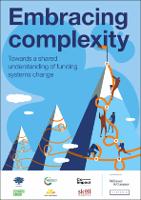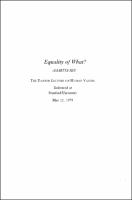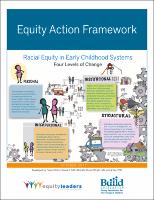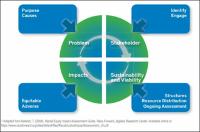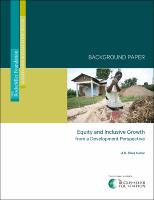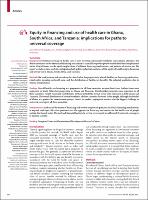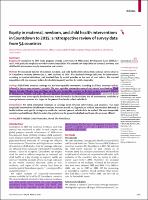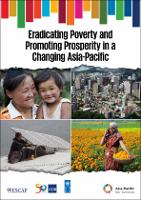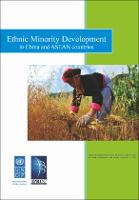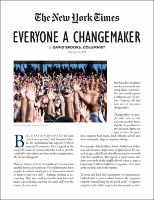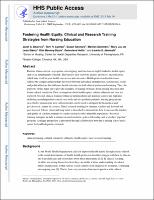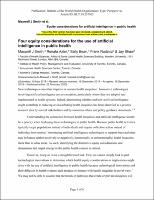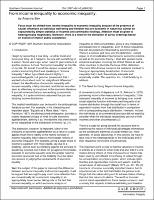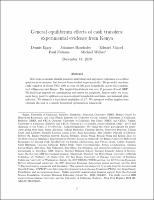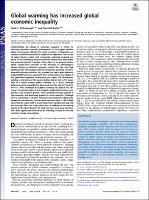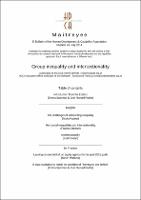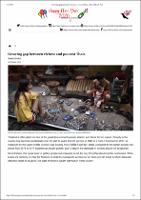Browsing by Title
Now showing items 79-98 of 229
-
Embracing complexity Towards a shared understanding of funding systems change
(2020-01)
The report is the result of collaboration between Ashoka and McKinsey & Company, as well as social entrepreneurs from Catalyst 2030, Co-Impact, Echoing Green, Schwab and Skoll and SystemIQ. How can systems change across the world be financed more effectively? How can change be better supported for the benefit of society? “Embracing complexity – Towards a shared understanding of funding systems change” provides donors and investors, as well as charitable initiatives and organizations, with answers to these questions. A clearly defined vision, ... -
Equality of What?
(Cambridge: Cambridge University Press., 1979)
Well-being is not just a question of the wealth or pleasure that a person has; it is a question of how people manage to live their lives and the ability they have to do certain things that are important to them. This was the argument put forward by Professor Amartya Sen in 1979. In his seminal Tanner Lecture – ‘Equality of What?’, Sen unites economics and philosophy to explore how a person’s well-being might best be measured. It was the first in a series of writings in which he developed his capability approach. This focuses on the actual capability ... -
Equity Action Framework
(2017)
Th e Equity Action Framework1 is designed to support individuals and groups that want to advance racial equity in early childhood systems. Th e goal of a racial equity approach is to develop policies, practices, and programs that provide opportunities, promote fairness and access, and remediate racial inequities. Whether working at national, state, county, or municipal levels of government, in private-public partnerships, community organizations, foundations or other entities, the Equity Action Framework provides an intentional process for ... -
Equity Action Framework
(Race forward, 2009) -
Equity and Inclusive Growth from a Development Perspective
(The Rockefeller Foundation)
Dr. A.K. Shiva Kumar wrote Equity and Inclusive Growth from a Development Perspective to supplement a series of workshops with Rockefeller Foundation staff in 2012 and 2013. The paper has since become the “go-to” source for knowledge about development concepts that are important to designing, implementing, monitoring, and evaluating the work of the Foundation. The paper establishes why growth is important and surveys the history of growth theories from the 1950s to the present. This includes approaches to growth such as equitable growth, ... -
Equity in financing and use of health care in Ghana, South Africa, and Tanzania: implications for paths to universal coverage
(The Lancet, 2012)
Background Universal coverage of health care is now receiving substantial worldwide and national attention, but debate continues on the best mix of financing mechanisms, especially to protect people outside the formal employment sector. Crucial issues are the equity implications of different financing mechanisms, and patterns of service use. We report a whole-system analysis—integrating both public and private sectors—of the equity of health-system financing and service use in Ghana, South Africa, and Tanzania. -
Equity in maternal, newborn, and child health interventions in Countdown to 2015: a retrospective review of survey data from 54 countries
(The Lancet, 2012)
Background Countdown to 2015 tracks progress towards achievement of Millennium Development Goals (MDGs) 4 and 5, with particular emphasis on within-country inequalities. We assessed how inequalities in maternal, newborn, and child health interventions vary by intervention and country. -
Equity, Diversity & Inclusion: A resource guide for Leaders in Collegiate Recreation
(NIRSA Commission on Equity, Diversity & Inclusion, 2019-02)
The publication, Equity, Diversity & Inclusion: A resource guide for Leaders in Collegiate Recreation, compiles foundational concepts, research-driven best practices, and case studies to help campus recreation professionals develop competencies around EDI – for their own personal and professional growth, as well as for their departments. The publication includes the following: Introduction to equity, diversity, and inclusion and the NIRSA EDI Identity Wheel. Definitions for a broad range of terminology associated with the nine identities focused ... -
Eradicating Poverty and Promoting Prosperity in a Changing Asia-Pacific
(United Nations, 2017-03-01)
This report is produced under a renewed partnership between United Nations (ESCAP), ADB, and the United Nations Development Programme (UNDP) to support national and regional efforts to implement the 2030 Agenda for Sustainable Development. It explores five megatrends that will determine whether everyone will be able to thrive and fulfill their expectations for a better life in the future: regional economic cooperation and integration; rural–urban transitions; demographic changes; ICT access and connectivity; and demand for natural resources. It ... -
Ethnic Minority Development
(2013)
This paper was presented in the sixth China-ASEAN Forum on Social Development and Poverty Reduction, which was held on 26-27 September 2012 in Liuzhou, China. The forum was supported under the UNDP-IPRCC project. Southeast Asia and China together constitute nearly half of the total global ethnic minority population. This chapter will address the challenge of the development of ethnic minority groups in the ASEAN region, and China -
Everyone a changemaker
(The New York Times, 2018-02-09) -
Eyewitness: VIETNAM WAR
(DK Publishing, Inc.)
The Vietnam War remains one of the most heroic and heartbreaking events in history. This definitive guide charts the unforgettable story of the world's first televised war. Hundreds of insightful images and a compelling narrative combine to chronicle this catastrophic conflict.?? From 1955, the communist government of North Vietnam waged war against South Vietnam and its main ally, the USA. Over the course of two decades of hostility and warfare, the number of casualties reached an incomprehensible three million people. Detailed descriptions of ... -
Fostering Health Equity: Clinical and Research Training Strategies from Nursing Education
(The Kaohsiung Journal of Medical Sciences, 2009)
Racism, ethnocentrism, segregation, stereotyping, and classism are tightly linked to health equity and social determinants of health. They lead to lack of power, money, resources, and education which may result in poor health care access and outcomes. Health profession faculties must address the complex relationships that exist between individual, interpersonal, institutional, social and political factors that influence health outcomes in both clinical and research training. Thus, the purposes of this paper are to provide examples of training ... -
From income inequality to economic inequality.
(Southern Economic Journal, 1997)
Focus must be shifted from income inequality to economic inequality because of the presence of causal influences on individual well-being and freedom that are economic in nature but cannot be expounded by simple statistics of incomes and commodity holdings. Attention must be given to heterogeneous magnitudes. Moreover, there is a need for the derivation of partial orderings based on explicit or implicit public acceptance. -
General Equilibrium Effects of Cash Transfers: Experimental Evidence from Kenya
(National Bureau of Economic Research, 2019-12)
How large economic stimuli generate individual and aggregate responses is a central question in economics, but has not been studied experimentally. We provided one-time cash transfers of about USD 1000 to over 10,500 poor households across 653 randomized villages in rural Kenya. The implied fiscal shock was over 15 percent of local GDP. We find large impacts on consumption and assets for recipients. Importantly, we document large positive spillovers on non-recipient households and firms, and minimal price inflation. We estimate a local fiscal multiplier ... -
Global warming has increased global economic inequality
(2019-05-14)
Significance We find that global warming has very likely exacerbated global economic inequality, including ∼25% increase in population-weighted between-country inequality over the past half century. This increase results from the impact of warming on annual economic growth, which over the course of decades has accumulated robust and substantial declines in economic output in hotter, poorer countries—and increases in many cooler, wealthier countries—relative to a world without anthropogenic warming. Thus, the global warming caused by ... -
Global warming has increased global economic inequality
(The Journalist's Resource, Shorenstein center on media, politics and public policy, Harvard Kennedy School, 2019-05-14)
Significance We find that global warming has very likely exacerbated global economic inequality, including ∼25% increase in population-weighted between-country inequality over the past half century. This increase results from the impact of warming on annual economic growth, which over the course of decades has accumulated robust and substantial declines in economic output in hotter, poorer countries—and increases in many cooler, wealthier countries—relative to a world without anthropogenic warming. Thus, the global warming caused by ... -
Group inequality and intersectionality
(E-Bulletin of the Human Development & Capability Association, 2014-07) -
Growing gap between richest and poorest Thais
(the ASEAN Post, 2019-10-25)

